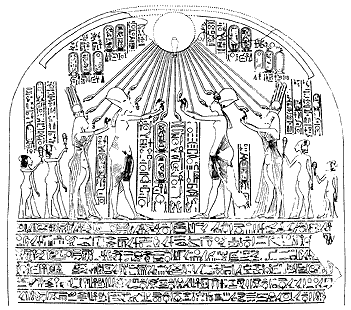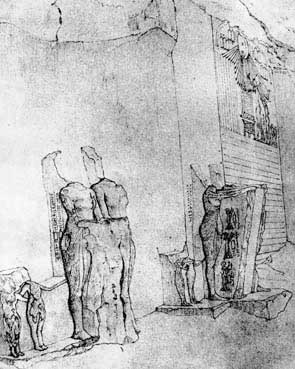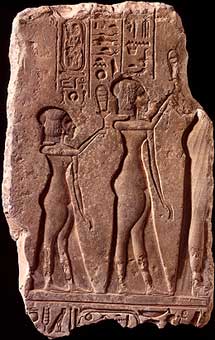|
|
|
|
|
What were the Boundary Stelae? These were markers placed around the city of Akhetaten, thought to show the limit of the city (and also presumably to make sure that no other gods were allowed within the boundaries). New thoughts on the layout of Akhetaten also show that that the placement of these stelae were not haphazardly done - the alignment matches very closely with the city and more importantly the tomb of Akhenaten. 
The inscription of one such Boundary stela - the king and queen are seen in the upper compartment, raising their hands in an attitude of prayer to the Aten, whose disk shines over their heads - each ray of light terminating in a hand giving life. Two royal daughters, Meritaten and Mekaten, accompany the King and Queen. The stela also records a date: 6th Year in the month of Pharmuthi, the 13th day.
Thereupon king Akhenaten swore an oath by his father thus: 'Sweet love fills my heart for the queen, for her young children. Grant a great age to the Queen Nefertiti in long years; may she keep the hand of Pharaoh! Grant a great age to the royal daughter Meriaten, and to the royal daughter Makaten, and to their children; may they keep the hand of the queen, their mother, eternally and for ever!' 'What I swear is a true avowal of that which my heart says to me. Never is there falsehood in what I say'. With regard to the southern memorial tablet, [of the] four [memorial tablets] on the east of the city of Akhetaten, let this be the memorial tablet which I will have set up in the place which I have chosen for it in the south, for ever and eternally. This memorial tablet shall be set up in the south-west towards the middle, on the mountain of Akhetaten, in the midst of it. With regard to the memorial tablet in the middle, on the mountain to the east of the city of Akhetaten, let this be the memorial tablet for Akhetaten. This I will have set up in its place [which I have appointed for it in sight of] the city of Akhetaten, at the place which I have appointed for it in the east, for ever and eternally.
Roughly two years after this Boundary Stela was carved a short text was added: 'This memorial tablet, which was placed in the middle, had fallen down. I will have it set up afresh, and placed again at the place at which it was [before]: this I swear. In the 8th Year, in the month Tybi, on the 9th day, the king was in Akhetaten, and Pharaoh mounted his court-chariot of polished copper, to behold the memorial tablets of the Sun's disk, which are on the hills in the territory to the south-east of Akhetaten. The phrase 'fallen down' has been taken to mean that this stela (and others which had similarly fallen down) had been destroyed by the Egyptians themselves disaffected with Akhenaten and his religious beliefs.  Pencil drawing made by Robert Hay in 1827 of Boundary Stela A, which once again shows Akhenaten, Nefertiti and their two eldest daughters making offerings - the figure of a third daughter had been added to the infill (and was therefore carved after Stela S above). |


